Texas Instruments Designing Photodiode Amplifier Circuits with OPA128 Application notes
- Type
- Application notes

1
e
OUT
= √4k TBR
k: Boltzman’s constant = 1.38 x 10
–23
J/K
T: temperature (°K)
B: noise bandwidth (Hz)
R: feedback resistor (Ω)
e
OUT
: noise voltage (Vrms)
while transimpedance gain (signal) increases as:
e
OUT
= i (signal) R
Signal-to-noise improves by √R.
• A low bias current op amp is needed to achieve highest
sensitivity. Bias current causes voltage offset errors with
large-feedback resistors. Wide bandwidth circuits with
smaller feedback resistors are less subject to bias current
errors, but even in these circuits, bias current must be
The OPA128 ultra-low bias current operational amplifier
achieves its 75fA maximum bias current without compro-
mise. Using standard design techniques, serious perfor-
mance trade-offs were required which sacrificed overall
amplifier performance in order to reach femtoamp (fA = 10
–15
A) bias currents.
UNIQUE DESIGN MINIMIZES
PERFORMANCE TRADE-OFFS
Small-geometry FETs have low bias current, of course, but
FET size reduction reduces transconductance and increases
noise dramatically, placing a serious restriction on perfor-
mance when low bias current is achieved simply by making
input FETs extremely small. Unfortunately, larger geom-
etries suffer from high gate-to-substrate isolation diode leak-
age (which is the major contribution to BIFET
®
amplifier
input bias current).
Replacing the reverse-biased gate-to-substrate isolation di-
ode structure of BlFETs with dielectric isolation removes
this large leakage current component which, together with a
noise-free cascode circuit, special FET geometry, and ad-
vanced wafer processing, allows far higher
Difet
®
perfor-
mance compared to BIFETs.
HOW TO IMPROVE PHOTODIODE
AMPLIFIER PERFORMANCE
An important electro-optical application of FET op amps is
for photodiode amplifiers. The unequaled performance of
the OPA128 is well-suited for very high sensitivity detector
designs. A few design tips for photodiode amplifiers may be
helpful:
• Photodiode capacitance should be as low as possible. See
Figure 1: C
J
affects not only bandwidth but noise as well.
This is because C
J
and the op amp’s feedback resistor form
a noise-gain zero (feedback pole).
• Photodiode active area should be as small as possible so
that C
J
is small and R
J
is high. This will allow a higher
signal-to-noise ratio. If a large area is needed, consider
using optical “gain” (lens, mirror, etc.) rather than a large
area diode. Optical “gain” is essentially noise-free.
• Use as large a feedback resistor as possible (consistent
with bandwldth requirements) to minimize noise. This
seems paradoxical, but remember, resistor thermal noise
increases as:
FIGURE 1. Photodiode Equivalent Circuit.
R
S
I
P
= photocurrent
R
J
= shunt resistance of diode junction
C
J
= junction capacitance
R
S
= series resistance
I
P
C
J
R
J
OPA128LM
2
3
6
HP
5082-4204
8
10
9
Ω
5pF
Responsivity ≈ 10
9
V/W
Bandwidth: DC to ≈ 30Hz
Offset Voltage ≈ ±485µV
10
9
Ω
FIGURE 2. High-Sensitivity Photodiode Amplifier.
DESIGNING PHOTODIODE AMPLIFIER CIRCUITS WITH OPA128
©
1994 Burr-Brown Corporation AB-077 Printed in U.S.A. January, 1994
®
SBOA061

2
I
SIGNAL
R
F
If: R
J
= ∞ and I
S
= 0
E
OUT
= –I
SIGNAL
R
F
+ V
OS
E
OUT
V
OS
I
SIGNAL
R
F
If: R
J
= ∞, I
S
= 0 and R'
F
>> (R
1
/R
2
)
E
OUT
= –I
SIGNAL
R'
F
(1 + R
1
/R
2
) + V
OS
(1 + R
1
/R
2
)
E
OUT
V
OS
R
2
R
1
FIGURE 3. Wide-Temperature Range Photodiode Amplifier.
• For highest sensitivity use the photodiode in a “photovol-
taic mode”. With zero-bias operation, dark current offset
errors are not generated by this (photodiode leakage)
current. Zero bias is a slower but higher sensitivity mode
of operation. Most photodiodes work quite effectively with
zero bias, even those originally designed for reverse-biased
operation.
• Fastest response and greatest bandwidth are obtained in
the “photoconductive mode”. Reverse bias reduces C
J
substantially and also reduces or eliminates the slow rise
time diffusion “tail” which is troublesome at longer wave-
lengths. Disadvantages of biased operation are: dark cur-
rent, 1/F noise component is introduced, and the occasional
need for an extra bias supply.
• A very high resistance feedback resistor is MUCH better
than a low resistance in a T network. See Figure 5. Although
transimpedance gain (e
OUT
/i
SIGNAL
) is equivalent, the T net-
work will sacrifice performance. The low feedback resis-
tance will generate higher current noise (i
N
) and the voltage
divider formed by R
1
/R
2
multiply input offset voltage, drift,
and amplifier voltage noise by the ratio of 1+
R
1
/R
2
. In most electrometer amplifiers, these input specifica-
tions are not very good to start with. Multiplying an already
high offset and drift (sometimes as high as 3mV and 50µV/
°C) by use of a T network becomes impractical. By using a
far better amplifier, such as the OPA128, moderate T net-
work ratios can be accommodated and the resulting multi-
plied errors will be far smaller. Although a single very-high
resistance will give better performance, the T network can
overcome such problems as gain adjustment and difficulty in
finding a large value resistor.
OPA128LM
2
3
6
Hamamatsu
G1735
8
400MΩ
≈ 0.4pF
400MΩ
1000pF
Responsivity ≈ –1.6 X 10
8
V/W
Spectral Response ≈ 400 – 760nm
Bandwidth ≈ 1kHz
Offset Voltage ≈ ±150µV at 25°C
≈ ±325µV at 60°C
OPA128
2
3
6
UDT Pin-040A or
SDC SD-041-11-21-011
8
1MΩ
≈ 0.5pF
Responsivity ≈ –5 X 10
5
V/W
Bandwidth ≈ 100kHz
Offset Voltage ≈ ±1mV
0.1µF
Bias Voltage
+10V to +50V
FIGURE 4. Wider-Bandwidth Photodiode Amplifier.
FIGURE 5. Feedback Resistors for Transimpedance Ampli-
fiers.
considered if wide temperature range operation is ex-
pected. The OPA128LM specs only ±2pA max at +70°C.
Bias current also causes shot noise.
i
S
= √2qi
q: 1.602 x 10
–19
coulombs
i: bias (or signal) current (A)
i
S
: noise current (A rms)
In most circuits, the dominant noise source will be the
thermal (Johnson) noise of the feedback resistor.
• Diode shunt resistance (R
J
) should be as high as possible.
If R
J
» R
F
, then the circuit DC gain (noise gain) is 1V/V.
Low resistance diodes will cause noise, voltage offset, and
drift to be amplified by 1+ R
F
/R
J
.
Since diode shunt resistance decreases at a higher tempera-
ture, it can cause unexpected errors. In Figure 3 a diffused-
junction GaAsP photodiode is used to maintain R
J
=
3000MΩ at +60°C. Due to its higher bandgap, GaAsP has
a flatter R
J
versus temperature slope than silicon.

3
• Shield the photodetector circuit in a metal housing. It is a
very high impedance, high sensitivity circuit and it requires
good shielding and effective power supply bypassing. This
is not optional.
• A small capacitor across R
F
is frequently required to
suppress oscillation or gain peaking. Although it can affect
bandwidth, a small amount of capacitance will usually be
required to ensure loop stability. This capacitor can be
made larger for bandwidth limitation if desired.
The information provided herein is believed to be reliable; however, BURR-BROWN assumes no responsibility for inaccuracies or omissions. BURR-BROWN assumes
no responsibility for the use of this information, and all use of such information shall be entirely at the user’s own risk. Prices and specifications are subject to change
without notice. No patent rights or licenses to any of the circuits described herein are implied or granted to any third party. BURR-BROWN does not authorize or warrant
any BURR-BROWN product for use in life support devices and/or systems.
KEY OPA128 SPECIFICATIONS
Bias current ..........................................................75fA max
Offset voltage ....................................................500µV max
Drift ................................................................. 5µV/°C max
Noise.................................................... 15nV/√Hz at 10kHz
BIFFET
®
National Semiconductor Corp.
; Difet
®
Burr-Brown Corp.

IMPORTANT NOTICE
Texas Instruments and its subsidiaries (TI) reserve the right to make changes to their products or to discontinue
any product or service without notice, and advise customers to obtain the latest version of relevant information
to verify, before placing orders, that information being relied on is current and complete. All products are sold
subject to the terms and conditions of sale supplied at the time of order acknowledgment, including those
pertaining to warranty, patent infringement, and limitation of liability.
TI warrants performance of its semiconductor products to the specifications applicable at the time of sale in
accordance with TI’s standard warranty. Testing and other quality control techniques are utilized to the extent
TI deems necessary to support this warranty. Specific testing of all parameters of each device is not necessarily
performed, except those mandated by government requirements.
Customers are responsible for their applications using TI components.
In order to minimize risks associated with the customer’s applications, adequate design and operating
safeguards must be provided by the customer to minimize inherent or procedural hazards.
TI assumes no liability for applications assistance or customer product design. TI does not warrant or represent
that any license, either express or implied, is granted under any patent right, copyright, mask work right, or other
intellectual property right of TI covering or relating to any combination, machine, or process in which such
semiconductor products or services might be or are used. TI’s publication of information regarding any third
party’s products or services does not constitute TI’s approval, warranty or endorsement thereof.
Copyright 2000, Texas Instruments Incorporated
-
 1
1
-
 2
2
-
 3
3
-
 4
4
Texas Instruments Designing Photodiode Amplifier Circuits with OPA128 Application notes
- Type
- Application notes
Ask a question and I''ll find the answer in the document
Finding information in a document is now easier with AI
Related papers
-
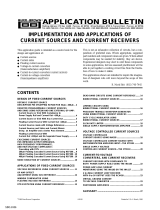 AB Amps 105 Application notes
AB Amps 105 Application notes
-
Texas Instruments Diode-Connected FET Protects Op Amps Application notes
-
Texas Instruments Transimpedance Considerations for High-Speed Operational Amplifiers Application notes
-
Texas Instruments AN-253 LH0024 and LH0032 High Speed Op Amp Applications Application notes
-
Texas Instruments High Speed Data Conversion Application notes
-
Texas Instruments Optoelectronics Circuit Collection Application notes
-
Texas Instruments DC Parameters: Input Offset Voltage Application notes
-
Texas Instruments Compensate Transimpedance Amplifiers Intuitively (Rev. A) Application notes
-
Texas Instruments Considerations for PCB Layout and Impedance Matching Design in Optical Modules Application notes
-
Texas Instruments Applying a New Precision Op Amp Application notes
Other documents
-
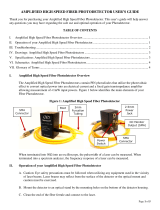 Newport 818-BB Amplified High Speed Fiber Photodetector User manual
Newport 818-BB Amplified High Speed Fiber Photodetector User manual
-
Broadcom Optocoupler Designer's User guide
-
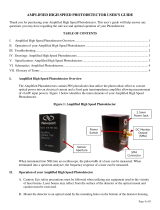 Newport 818-BB Amplified High Speed Photodetector User manual
Newport 818-BB Amplified High Speed Photodetector User manual
-
Philips TZA3046 User manual
-
 Newport 918D Photodiode Sensor User manual
Newport 918D Photodiode Sensor User manual
-
Analog Devices EVAL-ADA4350RUZ-P User manual
-
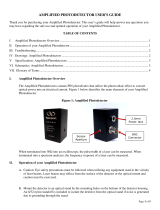 Newport 818-BB Amplified Photodetector User manual
Newport 818-BB Amplified Photodetector User manual
-
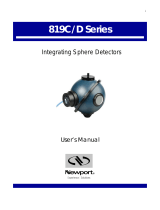 Newport 819C/D Series Integrating Sphere Detector User manual
Newport 819C/D Series Integrating Sphere Detector User manual
-
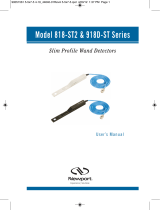 Newport 818-ST2 and 918D-ST Series Wand Detector User manual
Newport 818-ST2 and 918D-ST Series Wand Detector User manual
-
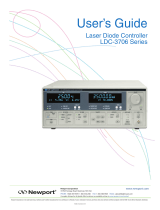 Newport LDC-3726 User manual
Newport LDC-3726 User manual











